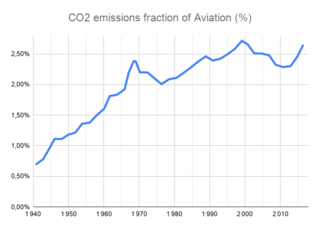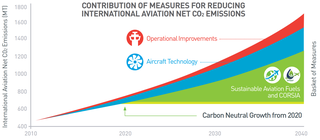Related Research Articles

The Kyoto Protocol (Japanese: 京都議定書, Hepburn: Kyōto Giteisho) was an international treaty which extended the 1992 United Nations Framework Convention on Climate Change (UNFCCC) that commits state parties to reduce greenhouse gas emissions, based on the scientific consensus that global warming is occurring and that human-made CO2 emissions are driving it. The Kyoto Protocol was adopted in Kyoto, Japan, on 11 December 1997 and entered into force on 16 February 2005. There were 192 parties (Canada withdrew from the protocol, effective December 2012) to the Protocol in 2020.

Carbon offsetting is a trading mechanism that allows entities such as governments, individuals, or businesses to compensate for (i.e. “offset”) their greenhouse gas emissions by supporting projects that reduce, avoid, or remove emissions elsewhere. In other words, carbon offsets focus on offsetting emissions through investments in emission reduction projects. When an entity invests in a carbon offsetting program, it receives carbon credits, i.e "tokens" used to account for net climate benefits from one entity to another. A carbon credit or offset credit can be bought or sold after certification by a government or independent certification body. One carbon offset or credit represents a reduction, avoidance or removal of one tonne of carbon dioxide or its carbon dioxide-equivalent (CO2e).

The European Union Emissions Trading System is a carbon emission trading scheme which began in 2005 and is intended to lower greenhouse gas emissions by the European Union countries. Cap and trade schemes limit emissions of specified pollutants over an area and allow companies to trade emissions rights within that area. The EU ETS covers around 45% of the EUs greenhouse gas emissions.
Flexible mechanisms, also sometimes known as Flexibility Mechanisms or Kyoto Mechanisms, refers to emissions trading, the Clean Development Mechanism and Joint Implementation. These are mechanisms defined under the Kyoto Protocol intended to lower the overall costs of achieving its emissions targets. These mechanisms enable Parties to achieve emission reductions or to remove carbon from the atmosphere cost-effectively in other countries. While the cost of limiting emissions varies considerably from region to region, the benefit for the atmosphere is in principle the same, wherever the action is taken.
Neste MY Renewable Diesel is a vegetable oil refining fuel production process commercialized by the Finnish oil and refining company Neste. Whether as an admixture or in its pure form, Neste MY Renewable Diesel is able to supplement or partially replace diesel fuel without problems. Neste MY Renewable Diesel guarantees that every gallon sold meets ASTM D975 and EN 15940 specifications in compliance with OEM standards.

Aircraft engines produce gases, noise, and particulates from fossil fuel combustion, raising environmental concerns over their global effects and their effects on local air quality. Jet airliners contribute to climate change by emitting carbon dioxide, the best understood greenhouse gas, and, with less scientific understanding, nitrogen oxides, contrails and particulates. Their radiative forcing is estimated at 1.3–1.4 that of CO2 alone, excluding induced cirrus cloud with a very low level of scientific understanding. In 2018, global commercial operations generated 2.4% of all CO2 emissions.

A hydrogen-powered aircraft is an aeroplane that uses hydrogen fuel as a power source. Hydrogen can either be burned in a jet engine or another kind of internal combustion engine, or can be used to power a fuel cell to generate electricity to power an electric propulsor. It cannot be stored in a traditional wet wing, and hydrogen tanks have to be housed in the fuselage or be supported by the wing.
The CRC Energy Efficiency Scheme was a mandatory carbon emissions reduction scheme in the United Kingdom which applied to large energy-intensive organisations in the public and private sectors. It was estimated that the scheme would reduce carbon emissions by 1.2 million tonnes of carbon per year by 2020. In an effort to avoid dangerous climate change, the British Government first committed to cutting UK carbon emissions by 60% by 2050, and in October 2008 increased this commitment to 80%. The scheme has also been credited with driving up demand for energy-efficient goods and services.
Carbon monitoring as part of greenhouse gas monitoring refers to tracking how much carbon dioxide or methane is produced by a particular activity at a particular time. For example, it may refer to tracking methane emissions from agriculture, or carbon dioxide emissions from land use changes, such as deforestation, or from burning fossil fuels, whether in a power plant, automobile, or other device. Because carbon dioxide is the greenhouse gas emitted in the largest quantities, and methane is an even more potent greenhouse gas, monitoring carbon emissions is widely seen as crucial to any effort to reduce emissions and thereby slow climate change.
European Business Aviation Association, or EBAA, is a non-profit association based in Belgium that has existed since 1977. Its more than 700 member companies cover all aspects of the business aviation sector in Europe and elsewhere. The EBAA's aim is to promote excellence and professionalism among its members and to ensure that aviation is properly recognized as a vital sector of the European Economy. EBAA represents corporate operators, commercial operators, manufacturers, airports, fixed-base operators, and business aviation service providers.
The UK Emissions Trading Scheme is the carbon emission trading scheme of the United Kingdom. It is cap and trade and came into operation on 1 January 2021 following the UK's departure from the European Union. The cap is reduced in line with the UK's 2050 net zero commitment.

Carbon emission trading (also called carbon market, emission trading scheme (ETS) or cap and trade) is a type of emission trading scheme designed for carbon dioxide (CO2) and other greenhouse gases (GHG). It is a form of carbon pricing. Its purpose is to limit climate change by creating a market with limited allowances for emissions. This can lower competitiveness of fossil fuels and accelerate investments into low carbon sources of energy such as wind power and photovoltaics. Fossil fuels are the main driver for climate change. They account for 89% of all CO2 emissions and 68% of all GHG emissions.
The Renewable Fuels Agency (RFA) was a UK Government non-departmental public body, created by the Department for Transport to implement the Renewable Transport Fuel Obligation or RTFO. The Agency ceased to exist at midnight on 31 March 2011 The Renewable Fuels Agency (RFA) was the UK's independent sustainable fuels regulator. The agency awards Renewable Transport Fuel Certificates (RTFCs) to suppliers of biofuels in the UK, ensures companies meet their annual obligations and runs the RTFO's carbon and sustainability reporting system.

An aviation biofuel is a biofuel used to power aircraft and is said to be a sustainable aviation fuel (SAF). The International Air Transport Association (IATA) considers it a key element in reducing the carbon footprint within the environmental impact of aviation. Aviation biofuel could help decarbonize medium and long-haul air travel generating most emissions, and could extend the life of older aircraft types by lowering their carbon footprint. The jargon synthetic paraffinic kerosene (SPK) refers to any non-petroleum-based fuel designed to replace kerosene jet fuel, which is often, but not always, made from biomass.
The Chinese national carbon trading scheme is an intensity-based trading system for carbon dioxide emissions by China, which started operating in 2021. This emission trading scheme (ETS) creates a carbon market where emitters can buy and sell emission credits. The scheme will allow carbon emitters to reduce emissions or purchase emission allowances from other emitters. Through this scheme, China will limit emissions while allowing economic freedom for emitters. China is the largest emitter of greenhouse gases (GHG) and many major Chinese cities have severe air pollution. The scheme is run by the Ministry of Ecology and Environment, which eventually plans to limit emissions from six of China's top carbon dioxide emitting industries. In 2021 it started with its power plants, and covers 40% of China's emissions, which is 15% of world emissions. China was able to gain experience in drafting and implementation of an ETS plan from the United Nations Framework Convention on Climate Change (UNFCCC), where China was part of the Clean Development Mechanism (CDM). China's national ETS is the largest of its kind, and will help China achieve its Nationally Determined Contribution (NDC) to the Paris Agreement. In July 2021, permits were being handed out for free rather than auctioned, and the market price per tonne of CO2e was around RMB 50, far less than the EU ETS and the UK ETS.

The New Zealand Emissions Trading Scheme is an all-gases partial-coverage uncapped domestic emissions trading scheme that features price floors, forestry offsetting, free allocation and auctioning of emissions units.
An Emissions Trading Registry is a web-based application that records:
The reduction of carbon emissions, along with other greenhouse gases (GHGs), has become a vitally important task of international, national and local actors. If we understand governance as the creation of “conditions for ordered rule and collective action” then, given the fact that the reduction of carbon emissions will require concerted collective action, it follows that the governance of carbon will be of paramount concern. We have seen numerous international conferences over the past 20 years tasked with finding a way of facilitating this, and while international agreements have been infamously difficult to reach, action at the national level has been much more effective. In the UK, the Climate Change Act 2008 committed the government to meeting significant carbon reduction targets. In England, these carbon emissions are governed using numerous different instruments, which involve a variety of actors. While it has been argued by authors like Rhodes that there has been a “hollowing out” of the nation state, and that governments have lost their capabilities to govern to a variety of non-state actors and the European Union, the case of carbon governance in England actually runs counter to this. The government body responsible for the task, the Department of Energy and Climate Change (DECC), is the “main external dynamic” behind governing actions in this area, and “rather than hollowing out central co-ordination”. The department may rely on other bodies to deliver its desired outcomes, but it is still ultimately responsible for the imposition of the rules and regulations that “steer (carbon) governmental action at the national level”. It is therefore evident that carbon governance in England is hierarchical in nature, in that “legislative decisions and executive decisions” are the main dynamic behind carbon governance action. This does not deny the existence of a network of bodies around DECC who are part of the process, but they are supplementary actors who are steered by central decisions. This article focuses on carbon governance in England as the other countries of the UK all have devolved assemblies who are responsible for the governance of carbon emissions in their respective countries.

The Carbon Offsetting and Reduction Scheme for International Aviation (CORSIA) is a carbon offset and carbon reduction scheme to lower CO2 emissions for international flights, to curb the aviation impact on climate change.

The Carbon Border Adjustment Mechanism (CBAM) is a carbon tariff on carbon intensive products, such as steel, cement and some electricity, imported to the European Union. Legislated as part of the European Green Deal, it takes effect in 2026, with reporting starting in 2023. CBAM was passed by the European Parliament with 450 votes for, 115 against, and 55 abstentions and entered into force on 17 May 2023.
References
- ↑ "Environmental Protection Agency". Archived from the original on 5 December 2020. Retrieved 12 August 2011.
- ↑ UK Use of IT Tools in the EU ETS Compliance Process, p4
- ↑ "Ebace Aero p.23" (PDF). Archived from the original (PDF) on 7 October 2011. Retrieved 15 August 2011.
- ↑ Edie Ireland News Article: Irish and British aviation emissions cutting work underway
<https://ets.epa.ie/Common/Help.aspx#gen20 Archived 5 December 2020 at the Wayback Machine /> <http://ec.europa.eu/clima/events/0008/s2_o_joel_uk_ea.pdf /> <https://web.archive.org/web/20111007100206/http://www.ebace.aero/2011/archives/presentations/20110518-wiese-eu-ets-operators-responsibility-liabilities.pdf />